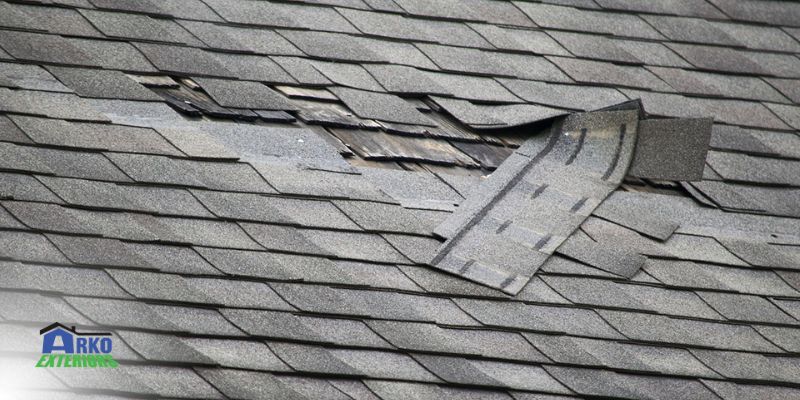Your roof’s shingles are the first line of defense against the elements. They protect your home from rain, snow, wind, and sun damage. However, even the toughest shingles can get cracked, curled, or blown off over time. When you start noticing bare spots on your roof where shingles are missing, it’s a sign that you may need roof repair or replacement soon.
Neglecting to replace missing shingles can lead to serious problems down the road.
Exposed areas leave your roof deck and attic vulnerable to moisture intrusion. This can cause rot, mold growth, and ultimately structural damage if left unchecked. Identifying and addressing missing shingle issues early is key to extending your roof’s lifespan and preventing costly repairs.
But how do you know when it’s time to call in the roofers? In this article, we’ll cover some telltale signs that missing shingles need to be replaced right away versus cases where you may be able to wait. We’ll also provide tips on properly inspecting your roof and weighing repair versus full roof replacement. Don’t let those bare spots turn into a bigger headache – read on to get informed on missing shingle maintenance.
1. Check for Widespread Issues
A few isolated missing shingles here and there may not be an immediate crisis. However, if you notice entire sections or slopes of your roof with numerous bare spots, it’s a sign of widespread shingle failure that needs to be addressed promptly. Widespread missing shingles expose a large area of your roof deck to potential water damage. It also indicates that shingles are nearing the end of their lifespan and failing prematurely. Addressing it comprehensively rather than spot repairs is usually advisable.
2. Look for Leaks
One of the biggest dangers of missing shingles is water infiltration. If you notice any leaks, stains, moisture buildup, or rot in your attic or on ceilings below areas with missing shingles, it’s an urgent situation to get repairs done before structural damage occurs. Water can quickly lead to mold, wood rot, insulation damage, and other costly issues the longer it goes unchecked.
3. Consider Shingle Age
How old are your roof’s shingles? Asphalt shingles are one of the most popular roofing materials but only last 15-30 years on average. If your shingles are over 20 years old and you’re seeing widespread failures with missing, cracked, or curled shingles, it may be more cost-effective to replace the entire roof rather than spot repairs. Older shingles become brittle and prone to wind damage.
4. Inspect After Storms
Missing shingles are one of the most common types of roof damage after high winds or hail storms. Inspect your roof thoroughly after any major weather event. Lift any remaining shingle tabs to check for cracking or broken seals underneath that could allow moisture entry even if the shingle is still partially attached.
5. Check Flashing
When inspecting missing shingles, also look at the condition of the surrounding flashing (the metal pieces installed in roof valleys and around vents/chimneys). If the flashing is old, cracked, or improperly installed, it can allow water to seep in behind missing shingles and cause hidden leaks.
6. Match Shingles
If you only have a few isolated missing shingles to replace, you’ll need to find very close matches in terms of color, style, and dimensions. Shingles from different lots or manufacturers can look jarring and unsightly when mixed on the same roof plane. Ask your contractor about the availability of perfect matches.
7. Replace Underlayment
For larger areas with multiple missing shingles, roofers may need to strip away the existing underlayment (asphalt paper or synthetic moisture barrier) in that section and install new underlayment before installing new shingles on top. This underlayment protects against any small gaps or cranny corners.
8. Ventilation is Key
Many shingle failures stem from improper attic ventilation leading to excessive heat and moisture buildup. When replacing missing shingles, have your roofer inspect ventilation and install additional vents if needed. This can extend the lifespan of your new shingles.
9. Consider a Roof Overlay
If you have just one layer of existing shingles and widespread issues, your roofer may recommend installing a completely new layer of shingles over the existing ones (called an overlay) instead of a full tear-off. This can sometimes reduce labor costs compared to a full roof replacement.
10. Full Replacement
In some cases, especially with older roofs or major issues, a full roof tear-off and replacement will be the best solution. This allows the installation of an entirely new waterproof underlayment, flashing, ventilation, and shingle system built to last. It’s more expensive upfront but could be worth it for peace of mind.
Conclusion
Missing shingles may seem like a minor nuisance, but leaving them unaddressed can lead to serious and costly roof leaks down the road. Whether you need a quick spot repair or a full roof replacement, it’s important to act swiftly once you identify bare spots.
A few key takeaways – if you notice widespread shingle damage spread across multiple roof sections, the shingles are over 20 years old, or you find signs of moisture infiltration, those are huge red flags that missing shingles need to be replaced immediately. But even smaller areas with just a few missing shingles require attention to prevent future leaks.
Inspect your roofregularly, especially after major storms, and get an experienced roofer’s assessment if you suspect missing shingle issues. Replacing shingles at the right time can prevent interior damage, remove eyesores, and maximize your roof’s longevity before a full replacement is required.
Don’t procrastinate on addressing missing shingles and jeopardize your home’s structural integrity. A proactive approach to roof inspections and repairs provides peace of mind for years to come and avoids cascading problems from simple neglect. Whether a quick fix or a bigger investment, prioritizing your roof preserves your largest asset – your home sweet home.

